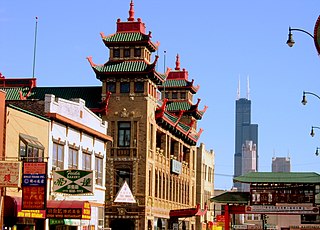
Armour Square is a Chicago neighborhood on the city's South Side, as well as a larger, officially defined community area, which also includes Chinatown and the CHA Wentworth Gardens housing project. Armour Square is bordered by Bridgeport to the west, Pilsen to the northwest, Douglas and Grand Boulevard to the east and southeast, and with the Near South Side bordering the area to the north, and Fuller Park bordering its southernmost boundary, along Pershing Road.

Lower West Side is a community area on the West Side of Chicago, Illinois, United States. It is three miles southwest of the Chicago Loop and its main neighborhood is Pilsen. The Heart of Chicago is a neighborhood in the southwest corner of the Lower West Side.

African-American art is a broad term describing visual art created by African Americans. The range of art they have created, and are continuing to create, over more than two centuries is as varied as the artists themselves. Some have drawn on cultural traditions in Africa, and other parts of the world, for inspiration. Others have found inspiration in traditional African-American plastic art forms, including basket weaving, pottery, quilting, woodcarving and painting, all of which are sometimes classified as "handicrafts" or "folk art".

The DuSable Black History Museum and Education Center, formerly the DuSable Museum of African American History, is a museum in Chicago that is dedicated to the study and conservation of African-American history, culture, and art. It was founded in 1961 by Margaret Taylor-Burroughs, her husband Charles Burroughs, Gerard Lew, Eugene Feldman, Bernard Goss, Marian M. Hadley, and others. They established the museum to celebrate black culture, at the time overlooked by most museums and academic establishments. The museum has an affiliation with the Smithsonian Institution.

Eldzier Cortor was an African-American artist and printmaker. His work typically features elongated nude figures in intimate settings, influenced by both traditional African art and European surrealism. Cortor is known for his style of realism that makes accurate depictions of poor, Black living conditions look fantastic as he distorts perspective.
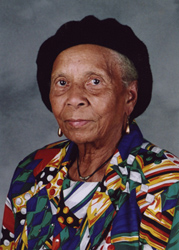
Margaret Taylor-Burroughs, also known as Margaret Taylor Goss, Margaret Taylor Goss Burroughs or Margaret T G Burroughs, was an American visual artist, writer, poet, educator, and arts organizer. She co-founded the Ebony Museum of Chicago, now the DuSable Museum of African American History.
Debra Hand is a self-taught artist and sculptor from Chicago, Illinois.

Archibald John Motley, Jr., was an American visual artist. Motley is most famous for his colorful chronicling of the African-American experience in Chicago during the 1920s and 1930s, and is considered one of the major contributors to the Harlem Renaissance, or the New Negro Movement, a time in which African-American art reached new heights not just in New York but across America—its local expression is referred to as the Chicago Black Renaissance. He studied painting at the School of the Art Institute of Chicago during the 1910s, graduating in 1918.
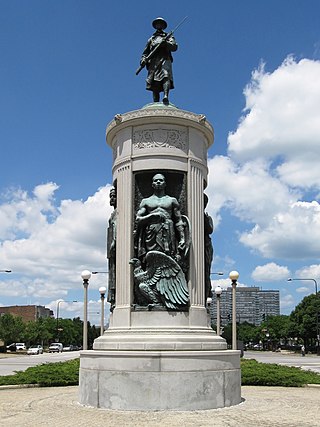
The South Side is one of the three major sections of the city of Chicago, Illinois, United States. Geographically, it is the largest of the three sections of the city, with the other two being the North and West Sides. It radiates and lies south of the city's downtown area, the Chicago Loop.

Todros Geller was a Jewish American artist and teacher best known as a master printmaker and a leading artist among Chicago's art community.

The Chicago Black Renaissance was a creative movement that blossomed out of the Chicago Black Belt on the city's South Side and spanned the 1930s and 1940s before a transformation in art and culture took place in the mid-1950s through the turn of the century. The movement included such famous African-American writers as Richard Wright, Margaret Walker, Gwendolyn Brooks, Arna Bontemps, and Lorraine Hansberry, as well as musicians Thomas A. Dorsey, Louis Armstrong, Earl Hines and Mahalia Jackson and artists William Edouard Scott, Elizabeth Catlett, Katherine Dunham, Charles Wilbert White, Margaret Burroughs, Charles C. Dawson, Archibald John Motley, Jr., Walter Sanford, and Eldzier Cortor. During the Great Migration, which brought tens of thousands of African-Americans to Chicago's South Side, African-American writers, artists, and community leaders began promoting racial pride and a new black consciousness, similar to that of the Harlem Renaissance. Unlike the Harlem Renaissance, the Chicago Black Renaissance did not receive the same amount of publicity on a national scale. Among the reasons for this are that the Chicago group participants presented no singularly prominent "face", wealthy patrons were less involved, and New York City—home of Harlem—was the higher profile national publishing center.

The San Diego County Administration Center is a historic Beaux-Arts/Spanish Revival-style building in San Diego, California. It houses the offices of the Government of San Diego County. It was completed in 1938 and was primarily funded by the Works Progress Administration. It was previously known as the San Diego Civic Center and as the City and County Administration Building. Because of its notable architecture and its location fronting San Diego Bay, it is nicknamed the Jewel on the Bay. Architects were Samuel Wood Hamill, William Templeton Johnson, Richard Requa and Louis John Gill. The building used innovative construction techniques to guard against earthquakes, and the project was considered to be "a prototype of American civic center architecture". The building was listed on the National Register of Historic Places on May 16, 1988.

Two Centuries of Black American Art was a 1976 traveling exhibition of African-American art organized by the Los Angeles County Museum of Art (LACMA). It "received greater visibility and validation from the mainstream art world than any other group exhibition of work by Black artists." According to the Grove Encyclopedia of American Art, the "landmark" exhibition "drew widespread public attention to the contributions to African American artists to American visual culture."
Walter Ellison (1899–1977) was an African American artist, born in the state of Georgia.
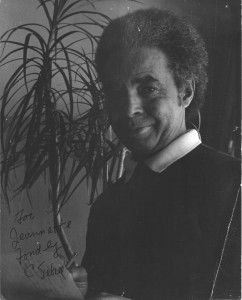
Charles Sebree (1914–1985) was an American painter and playwright best known for his involvement in Chicago's black arts scene of the 1930s and 1940s.

Eric Gugler was an American Neoclassical architect, interior designer, sculptor and muralist. He was selected by President Franklin D. Roosevelt to design the Oval Office.

Eleanor Gorecki Himmelfarb was an American artist, teacher and conservationist known for semi-abstract paintings that reference the landscape and human figure, and for her work protecting woodlands in DuPage County, Illinois. She studied art history and design at the University of Chicago, natural history at the Morton Arboretum, and fine art at the Art Institute of Chicago and University of Illinois at Chicago. Critics characterize Himmelfarb as a modernist, who explored her subjects metaphorically through complex rhythmic compositions, stylized forms, and subtle coloration. Her work was featured in solo shows at the Evanston Art Center (retrospective), University Club of Chicago and Sioux City Art Center, and group exhibitions at the Art Institute of Chicago, Chicago Cultural Center, and Renaissance Society. Himmelfarb taught painting and design for four decades at several institutions, including over 30 years at the DuPage Art League. She was married to the painter, Sam Himmelfarb, and helped him design their house, the Samuel and Eleanor Himmelfarb Home and Studio in Winfield, Illinois, which is listed on the National Register of Historic Places. Their son, John Himmelfarb, and grandchild, Serena Aurora, are also artists. Himmelfarb died at age 98 in Winfield in 2009.
William Thacker McBride Jr. was an African-American artist, designer and collector. McBride began his career in the 1930s in the circles of black art collectives and artistic opportunities afforded by the Works Progress Administration. He would ultimately leave his mark in Chicago as a driving force behind the South Side Community Art Center. McBride distinguished himself as a teacher, as a cultural and political activist, and as a collector of African art and artwork by black artists of his generation.
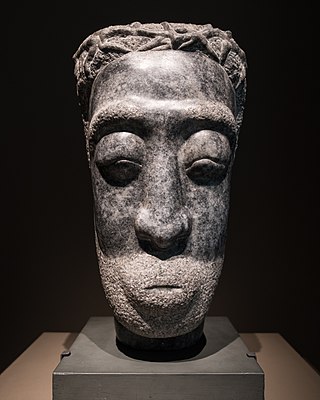
Marion Marche Perkins was an American sculptor who taught and exhibited at Chicago's South Side Community Art Center and exhibited at the Art Institute of Chicago. Perkins is widely considered an important artist of the Chicago Renaissance.
Susan Cayton Woodson was an American art collector and activist. A central figure in the Chicago Black Renaissance, she was critical in promoting and collecting works by black artists, such as William McBride, Eldzier Cortor, and Charles White.


















